SERGIO
ARAGONES
The
Art of Pantomime Cartooning
Sergio Aragones draws funny pictures. The same might be said for any cartoonist who cultivates the public's risibilities. In fact, in the popular mind, "drawing funny pictures" is the job description for all cartoonists. But in Aragones' case the description is not only apt: it is literally true. He is that rara avis who specializes in wordless visual comedy—the pantomime cartoon. His pictures—by themselves, without verbal accompaniment—provoke the laughter.
Aragones
first burst upon the national consciousness in early 1963 when his
tiny wordless comic drawings began decorating the margins of the
pages in Mad magazine.
But Aragones' chief undertaking since 1982 is a comic book called Groo about a
catastrophically stupid barbarian warrior in some by-gone age before
recorded history. Groo, unlike most of Aragones' creations, does not
commit his adventures in silence: he speaks, his persiflage
generated by writer Mark Evanier from Aragones' hints and nudges in a pencilled version of the story.
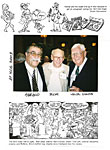
The reason Aragones gets Evanier to dub words into Groo's mouth is that the cartoonist does not believe that he has mastered the English language sufficiently for the task of composing dialogue. Born in Spain but raised in France and, after the age of five or six, in Mexico, Aragones adopted English as his third tongue, and his idiosyncratic deployment of the language is legendary, strenuously suggesting that English is still, as far as Aragones is concerned, an orphan.
The editors of The Comics Journal, to whom Aragones gave an interview in 1989 (No. 128, April), observed that "command of the language" was probably not the right expression to use in discussing his use of English: "Aragones sometimes appears subordinated to the torrent of words that flows from him," they wrote. "Yet this does not stop him from being one of comics' great conversationalists—articulate, funny, opinionated, and possessed of a limitless supply of marvelous anecdotes. After a few minutes, the listener becomes so accustomed to the random distribution of prepositions, the hit-and-miss approach to tenses, and, most of all, the majestic accent that 25 years of life in the United States could not muffle, that he begins to believe this is the only way English should be spoken."
Indeed. And it is a distinct pleasure to have a conversation with him. But the legend about his abuse of the language overstates somewhat the fact, doubtless exaggerating for comic effect. Aragones' embrace of the English vocabulary is all-encompassing, and his use of it is discriminating and precise. Only his syntax wobbles sometimes; his grammar, not at all. It’s his accent and only his accent that gives rise to the myth that Sergio is linguistically challenged in English. While I made some adjustments in his lingo as I transcribed our conversation, the tinkering was minor—and not very frequent.
I met Sergio at the San Diego Comic Convention in July 1991. One of the most gregarious of cartoonists, Sergio sat at a table for long hours every day, autographing copies of one of his books, sometimes decorating the endpaper with a drawing and all the while keeping up a running patois that was warm with the obvious affection and regard he has for his fans and fellow cartoonists.
Aragones never studied art, but, he says, "I was always drawing [as a kid]. I was never a good artist. I was just a drawer. I was the guy who told stories to himself and drew at the same time." He taught himself to draw by copying other cartoonists (a highschool favorite, Virgil Partch—the celebrated Vip). He began selling cartoons while still in high school. From the start, he focussed on wordless humor.
He brings to his cartooning a variety of (often related) experiences. Although he went to college in Mexico to become an architect, he acted in a theater group while there and, later, in movies and plays in the U.S. And he studied mime with Alexandro Jodorowsky. He has worked as a stuntperson, animator, and photographer.
Aragones arrived in New York in 1962 with $20 in his pocket, and that was soon gone. He earned enough to live on by reciting flamenco poetry during the evenings in a Greenwich Village coffee house. During the day, he drew cartoons, and once a week, he made the Wednesday ("look day") rounds to the offices of the cartoon editors for such magazines as Saturday Evening Post, Look, True, Collier's, and the like. The cartoon editors weren't accustomed to pantomime cartoons. "Everybody said, These are very weird cartoons," Aragones remembered, "and they told me to go to Mad."
So, after hearing this advice repeatedly, Aragones finally went to Mad and showed his cartoons to Jerry DeFuccio and Nick Meglin, and they bought enough to make a two-page feature about astronauts.
Sergio chuckled. "The mistake they made was in telling me, Sergio, here at Mad, mi casa, su casa. And I took it literally. I never left. I've been there ever since."
Before long, Aragones was drawing tiny marginal pantomime cartoons for every issue of Mad. At first, the editors were skeptical about whether the diminutive doodles would work. "They told me, We'll run them until you run out of ideas. So far I haven't missed an issue yet, and it's been over 27 years. They put about 25 in every issue, so that's several thousand of them."
He became interested in wordless cartooning while growing up in Mexico. "We got cartoons from all over the world. And when they were in a different language, like the American or British cartoons, I didn't understand them. Daily strips were translated into Spanish, but gag cartoons weren't, and I have always been interested in gag cartooning. But European cartoonists—like the French—they had pantomime cartoons, gags without words. And those I could understand, and I thought it was fascinating, being able to do cartoons without words. So from the very beginning, it was a big attraction for me."
Pantomime cartooning is a distinct genre in the medium, and doing wordless cartoons is an exacting exercise.
"What happens is like a supersimplification," Aragones explained when we talked in October 1991. "Something you can say with words, you have to eliminate all the words until it can be told in a little story without words. You just think a little longer. But it becomes rewarding in the end because everybody can understand your cartoons no matter what your nationality. And that, to me, has been always a big thing—to do cartoons that everybody can understand, every age, every nationality. It is different. It's like in the theater. You have regular theater, and you have pantomime, like Marcel Marceau or Alexandro Jodorowsky. And I apply that to cartooning and it works."
But pantomime cartooning is "very limiting," Aragones told me. "If there are gags that need to be explained with words, I'm powerless. So I work more with cliches and stereotypes and with basic situations that everybody knows."
In a pantomime cartoon in which all the humor must arise from the visual presentation with no help from words, the drawing becomes absolutely vital. Readers have to understand immediately what they see.
"The action must be very clear," Aragones said. "And the [facial] expressions have to be exact. So even though my drawings look very loose, I spend a lot of time developing the little gag. You do it a few times until it comes out right. A drawing may look simple, but with practice, you can make it simpler. With the marginals—I have to do so many gags and put them in such small space that they have to be really simplified. So I take out a lot of elements that could be distracting. I draw them very small—only twice-and-a-half the size they're printed—so that I am not tempted to put detail in them. If you draw them small, you aren't likely to put in buttons and all kinds of other things that you automatically want to put in to improve the drawing. I use only those elements that everyone can understand right away. And I draw with a mechanical pen so the line doesn't get thick and thin and get confusing."
"You mentioned stereotypes," I said, "and stereotypes are certainly one of the tools of the cartooning trade. But in these days of raised feminist consciousness, we can get in a lot of trouble with stereotypical images of pretty women—sexy girls in particular."
"Yes, I have trouble," Aragones said. "For instance, I would love to draw a female doctor. But the moment I draw a female doctor, the mind [of the reader viewing the cartoon] will immediately think it's a nurse. And they will look for the gag someplace they're not supposed to be looking. Then I will have broken the general rule that says we should not distract the reader from the focal point of the gag. So I cannot draw a female doctor no matter how much I want to. The world hasn't accepted female doctors yet. And I must draw what the world has accepted. Once the world thinks women doctors are normal, then I can draw a woman doctor with no trouble. It has nothing to do with us cartoonists being chauvinists: it's that the world hasn't accepted these things yet."
Even while turning in his monthly quota for Mad, Aragones occupied himself with numerous other endeavors. He went to Europe for two years (1966-67), and when he returned, he started plotting stories for some of the humorous titles at DC Comics (Angel and the Ape, Binky and His Friends, Jerry Lewis, and the like), and he created and produced, with Denny O’Neil and Nick Cardy, the western character, Bat Lash. Aragones plotted the stories and O’Neil finished them, polishing the dialogue; then Cardy drew the pictures. In 1973, Aragones co-created the humor comic book, Plop! Plop! ran for three years (1973-76), 24 issues. It failed, Aragones believes, simply because American comic book readers want adventure, not humor, in their comics.
"If you draw something humorous," he said, "automatically they want to put you in a category all by itself. Humor is considered to be for children." But that isn't true in Europe. "In Europe, they take a serious adventure story, and they draw it in a humorous style. Here, a humorous style is for gags; for adventure, there's a realistic style. Our closest approximation of the European style is a comic book like Donald Duck. And Mickey Mouse. Remember in the beginning when Mickey Mouse had these incredible adventures? Those were real good adventures. And then there was Roy Crane with that little guy—Wash Tubbs. Wash Tubbs and Captain Easy."
"Oh, right," I said. "And, now that you mention Crane, it's funny that there's so little humorous drawing for adventure strips because Crane's work on Wash Tubbs was admired and studied by many of the cartoonists who drew newspaper adventure strips in the early and mid-thirties. Milton Caniff was a student of Crane's technique. All these guys studied Crane—his panel composition, his casting, his pacing—but they all went on and developed a realistic style of drawing while Crane went right on drawing big-foot comedy characters—"
"Which were terrific!"
"Yes!" I agreed. "It worked wonderfully. Just beautiful. Despite the comic drawings, you knew the story was for real. There was authentic bloodshed there. You knew that when Bull Dawson was beating up on somebody, it was a serious threat to life and limb. Even if he had big feet."
"Yes," Aragones said, "and Crane knew how to draw. Just a few lines. A lot of cartoonists did humor in newspaper comic strips, but that tradition never went into the comic books. And it's a shame."
And then in 1982, along came Groo, and there was humor in comic books. Aragones' humor.
Groo (originally entitled Groo the Wanderer) didn't sell as well as the superhero comic books. It didn't revolutionize the industry, converting the buying public from lovers of super heroics to lovers of humor. But it sold well enough to have attracted the attention of the world's biggest comic book publisher at the time, Marvel.
When Groo first appeared in print, it was published by a small, independent publisher, Pacific Comics, and when Pacific shut down, Groo's creators approached Marvel. And Marvel wanted Groo enough to agree to Aragones' terms: he had resolved several years earlier never to draw a comic book that he didn't own. Marvel agreed to publish and distribute a comic book owned by its creator.
The basic premise of Groo is simple: Groo is a freelance barbarian warrior who loves a good battle (or "fray," as he says continually). And he is very good at fighting. He excels at it. He's probably the best man with a sword in his part of the world (wherever that is). But he is so monumentally dumb that his every endeavor wreaks havoc with everyone close to him.
Aragones produces Groo in close collaboration with Evanier. The production team also includes letterer Stan Sakai and colorist Tom Luth. In the 1989 interview with Kim Thompson at The Comics Journal, Aragones described the collaborative process.
When he has an idea for a story, Aragones discusses it briefly with Evanier and then begins developing the story. First, he breaks the storyline into 22 pages, sketching the action very roughly. Next, he draws the final art, working in blue pencil on boards one-and-a-half times larger than the printed product appears. Then he takes the pages to Evanier and "reads" the story to him.
"If Mark understands what I have there," Aragones continued, "then he goes and writes the dialogue correctly. He puts the [verbal] gags in it and writes the poetry. Often he changes the order of the story. Sometimes he makes a change in the ending. Sometimes I don't agree with what he has done, and we talk about it and change things back. But that's very rare because he's a very good writer. And if his change makes more sense—I'm not a fool. Anything that improves it, I take!"
The Groo stories are carefully paced. They build to gags, and very often, pages end with a gag. And sometimes Aragones knows his story calls for a verbal gag at a particular point, but he leaves the gag to Evanier.
"Sometimes I see where a joke—a verbal gag—could go," Aragones said, "so I write, Joke here. Or, Mark --please save this panel." He laughed. "Or, Put Markism here. And he does that. Sometimes when I get the pages back, I laugh my head off because I didn't know what the gag was going to come out like. If there's a situation in which something funny gets said, I don't write that particular funny saying. But I know it is going to go there: I set it up for a gag to be in that place."
After Evanier has written the dialogue, the pages go to Stan Sakai, who letters them. Then the pages come back to Aragones, who reviews his pencilled work in the light of the verbiage that now embroiders the action. "I didn't know what the dialogue would be exactly, so sometimes I have to change the expressions on characters' faces to fit the dialogue," he explained.
Then he inks the pages. Aragones' pencils are very loose, very rough.
"What I do with a pencil is place the character," he told me, "I don't pencil the details. I just sketch the figure into position. But when I have some detail that is essential to the drawing—if somebody is cutting something with a sword, for instance—then I have to pencil it more carefully so that the cut goes exactly where I want it. But usually, I pencil just to position the figures. So I would never be able to have an assistant do my inking because there are no lines to follow—just little circles here and little circles there, and once in a while, a little thing. I leave the expression to my inking."
Aragones inks with a series of fountain pens. Although he fills them with India ink, the ink does not coagulate. "I'm drawing all the time, so the pens never have time to dry up," he says. He doesn't clean them either. "I just keep refilling them and use them every day. I have pens that have lasted for five, six years—the same pen. Pelican pens."
The pens have different points: one is flexible with a fine point; another is broad; a third is medium. "If I'm doing backgrounds," Aragones said, "I use my thin point. When I do drawings in the foreground, I use a thicker one."
Aragones prefers fountain pens because they enable him to draw without stopping to dip a pen into an inkwell. "One of the things I like about my drawing is the looseness of the style," he said, "and that I achieve with a continuity of line. The line doesn't stop. I don't stop drawing it. My thoughts, my train of thought, is attached to the drawing. I'm thinking as I'm drawing. So I don't want to get distracted. I'm going with the line and going and going—and I don't want to have to stop and fill up with ink. Then I'd come back to the drawing and say, Oh, my god—what was my thought here?"
Aragones draws rapidly, turning the paper periodically to orient the drawing to the most comfortable motion of his hand. He'd draw slower, he told me, if he were making realistic drawings. But he does cartoony drawings best when he does them quickly.
For a cartoonist who draws big-foot comedy, he does a great deal of research. Groo is crammed with background detail and authentic-looking weaponry and equipage. The authenticity is painstakingly achieved—and then, typically, given an unrealistic wrench.
"If I'm doing a scene in a seaport," Aragones said, "I might start with a ship that belongs to the 18th century—like a square-rigger. And then I distort it. I might give it a square back from another period, or Chinese-type sails. So everything is mixed. It doesn't look like an 18th century square-rigger anymore so the reader doesn't expect to find the 18th century in Groo."
I asked him what all that detail contributes to the product.
"A feeling," he said. "Whether you're doing humor or adventure, your duty as an artist or a writer is to make the reader feel comfortable with what he's reading—to be able to follow the story and not be distracted by something that doesn't belong there. There are so many [comic book] artists now who want to express their ART," he continued, capitalizing every letter in the word. "They use the comic book as a vehicle for their ART, and it doesn't belong there. Now there's room for everybody in this business, and I don't object to them doing what they do, but they've gotten confused about what the medium is. Comic books tell stories. And they put in this avant garde type drawing and the drawing's so confusing—the anatomy is totally wrong—but the main point of the story gets lost in the midst of all this ART."
But Aragones doesn't put research and visual detail into his drawing for the sake of Art. He does it to make his reader feel the ambiance of the place of the action.
"I don't want to take a shortcut and just do a few lines in the background," he said. "If Groo is going to be in a castle, I draw a schematic of how the story is going to develop, and I make a drawing of the castle, too—a plan of it. So if Groo is on one side and goes to the other, the right side of the castle will be shown in the panels. I do complete plans of everything. I enjoy doing that. And the reader—even if he doesn't know all this is happening—he will look at it all and understand the story; he will not be distracted by things that don't seem to belong or that don't seem right."
One- and two-page splash panels in Groo are jammed with Aragones' hoked-up ambiance—all kinds of details, buildings and (seemingly) hundreds of people, animals, carts and other accoutrements. Such pictures take hours to draw, but Aragones rations out his time over several days, sometimes weeks.
"I have to do a comic book a month [in 1991]," he explained, "and to do that, I do a page a day. But a big spread will take two or three days and that will put me behind. So what I do is I draw the basic situation one day, and then I do a little bit more on it the next day and the next and so on after I've done my page for each day. There are certain times of the day when I work on it. When somebody calls on the phone or comes to visit and it's a long conversation, I take the large panel and start penciling crowd scenes."
Suiting his action to his words, Sergio was working on a market scene as we talked, drawing a cow—penciling the horns of the cow.
"Eventually," he continued, "I fill up the page with little bits, and by the end of the month, the page is finished. You put a lot of work in on it, but it's not rushed work."
"So there's this marketplace," I said, "and you know that it's going to be filled with people and animals and stalls and—"
"What you do is, you go there," Aragones said. "You transport yourself there. I've done a lot of traveling and I'm a super fan of National Geographic, so I put myself into this mythical marketplace and then as I walk down the street, I start remembering marketplace details I've seen in various places—I remember the vegetable stand and the ox cart—and I start inventing and drawing and adding to the picture, and before long, it is a market. If you are drawing a mass scene of a battle, then you concentrate on each individual warrior in that scene. If you are in a rush because you have a deadline for that page—which happens when you have to do hundreds of pages and you're not paid very much for any of them—you just draw generic soldiers fighting, and sometimes they are not even fighting with anybody. They're just floating all over the place— "
"Yes, waving their weapons in the air."
"Right," he agreed with a laugh. "But if you give yourself time to do a big battle scene—and you should—then you go and you get into that battle. And you see this guy fighting here and that guy fighting over there—”
"And each one has his particular problem so the battle becomes a whole series of individual encounters—just like the real thing."
"Right."
Aragones admits he could get away with less. He could draw backgrounds with a few lines. "But I'm not interested in that," he says. "And I'm the guy who spends eight hours a day drawing it. I'm the guy who has to enjoy drawing it."
Sergio does most of his drawingboard work at night. "It's quiet, very peaceful. No interruptions. Nothing. I don't think at night: I ink at night. During the day is when I think. My head is fresh. I walk from one place to another. I go to the lake or sit by the pool and just think."
His typical day begins about noon when he awakens, breakfasts, and goes downtown to do a few chores and to visit the post office. He always takes a pad of paper with him. He stops to have coffee at a favorite spot. All the time, he is thinking—"thinking ideas, thinking of my plot." Sometimes he goes to the park; sometimes he gets in his car and drives somewhere—"some place very beautiful, and then, in total quietness, I think."
About three or four o'clock in the afternoon, he comes to his studio to put his thoughts on paper. His studio is cluttered with souvenirs—toys and figurines and books on shelves all over; and on the walls, masks and all kinds of original cartoons from friends. And all of this, Aragones says, helps inspire him. Surrounded by objects and art he loves, he settles in at the drawingboard and draws.
"My mind is tired by this time," he said, "and so I do the inking which doesn't take much concentration. I put on the television, and I watch the news and movies while I'm inking, and the time passes very comfortably. Then I get a phone call from home: Come home, it is three o'clock in the morning!"
To that classic inquiry—Where do you get your ideas? —Sergio has a playful reply:
"When kids ask me, I tell them—Well, they're floating in the air like little balloons. There are little balloons for musicians and there are little balloons for writers and for sculptors and for poets—whatever you are, you just pick your balloon and use it. I'm a cartoonist, and the sky is full of little balloons full of gags, so I just pick the ones I need. And I want to do it before somebody else picks them, so I'm there fighting to get the best ones."
Sergio laughed. "No, I get ideas from where everybody else gets theirs. You sit there, and you work at it. There's no magic; there's no mystery. You sit, and you think."
"But sometimes," I suggested, "the idea comes from the nature of the drawing, doesn't it? Let's say you're doing a vertical drawing for one of the Mad marginals. Just the fact that it's vertical means something: there are only a certain number of situations that can be portrayed vertically. I remember one of your verticals: a picture of a guy falling down the side of a building, and at every window of the building stood a beautiful girl, and the guy was falling past the windows and obviously enjoying himself looking in on all these pretty women. Part of the origin of that idea had to be that it was a vertical drawing."
"Yes," Aragones said. "If you're going to do jokes about firemen, you're not going to think elephant. For a vertical gag, I think in that direction: I think giraffe, I think ladders, I think things that fit into that shape. Man falling out of a building. What can happen? Imagine the irony: the guy is committing suicide, and there it is. A lot of beautiful women around, so he's looking at them."
Aragones said he's never really been at a loss for ideas. "There's no such thing as no ideas," he told me. "It's just that maybe you don't feel like working. Your head is not at it right now. The ideas aren't coming. But that doesn't mean there are no more ideas. If you are very tired, you don't feel like walking, but that doesn't mean that your legs are not functioning. Your brain never stops."
Sometimes he coaxes himself into the right frame of mind to work at getting ideas. "When you're writing or drawing, there's a stream of consciousness," he explained. "So you have to sit there and do it. Just because nothing is coming right away doesn't give you the excuse to go away and leave it. Once you sit there—even if you don't feel like writing—if you just sit there and start playing with your paper," he continued in a sing-song rhythm, "and do some drawing—and then you begin to feel much better—and your troubles go away—and there you are, working again." He chuckled.
But Aragones says most of his ideas are generated by thinking. "I do my best writing when I am in an airplane. I am a prisoner in that seat, so I just sit there, close my eyes and think. Think of elements. Visualize. Without the distraction of the drawing. And then—boom!—you get it."
Aragones spends a good deal of time in airplanes. He loves to travel. "I like to see how the rest of the world lives," he said. "The things I've seen in pictures, I want to see in reality. I wanted to see the Himalayas: I wanted to visit the monasteries and the monks. So I did all of that. And I'm very glad I did: you realize that there shouldn't be wars because you have met the people who are there. It's a beautiful brotherhood—all over the place."
And wherever he goes, he runs into other cartoonists. And in this manner, he discovered a kind of universal fellowship, a sort of fraternity.
"I found out that all the cartoonists—all over the world—know each other," Sergio said. "Cartooning, as you know, is not something you learn in school. It's something that you have within you. But it just happens that the same thing goes on inside all cartoonists all over the world. When the young cartoonist was in school, he was the guy drawing, and the teacher was complaining that he draws all the time and doesn't pay attention in class. And his parents tell him to pay attention. No matter what country or language, cartoonists have the same history and experiences. So wherever you run into a cartoonist, you know your backgrounds are the same even if your politics are different."
Aragones delights in meeting fellow cartoonists in other lands. "When I went to Brazil, I picked up a phone at the airport and called a cartoonist whose work I had seen—Ziraldo. I called him—This is Sergio Aragones, I said. I had never met him, but we knew each other—all of our lives! I knew his work; he knew my work, and he'd read interviews with me. We were like old brothers. And in France, it is the same thing: you know them, they know you. And it doesn't take too much time to develop a very good friendship, believe me."
Aragones' friends from around the world don't hesitate to call on him for help either. Once he had an emergency phone call from Francois Walthery, who draws the delectable Natacha, an adventurous airline stewardess.
"He does incredible research," Sergio said. "And he needed something about Los Angeles. He gave me the route of the character from the airport to the place they were going—the University—and he said he needed pictures of things along the route. So I took my car and followed the route and took photographs and drew sketches of things I thought he might be able to use—details of things that people would see on their way out of the airport, taxi stands and signs along the freeway and so on. I sent pictures that I took or drew. And he used it all, and when you see it, you could swear those characters are in Los Angeles. It is Los Angeles."
Aragones' advice for young cartoonists: "Take the career seriously. Things don't happen immediately. It takes time. But if what you want is money, you should pick another career. You don't pick this career for the money: you pick it because you enjoy doing it. And if you don't enjoy it more than anything else, then you should start thinking of something else to do. But if you enjoy sitting at a drawingboard and drawing more than anything else, then the only thing is to do it. Practice. Take it seriously and study and learn. Find out what other cartoonists are doing and copy the cartoonists you like until you eventually develop your own style. Cartooning is like playing an instrument: you cannot sit down at the piano and play a complete lullaby or a symphony or concerto just because you go to sit at a piano. You wouldn't be able to put five notes together. Same thing with cartooning. You have to practice. And the more you practice, the better you become. No mystery."
Now here’s a Groo Gallery for your amusement and edification.
 |
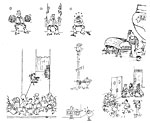 |
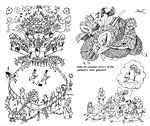 |
 |
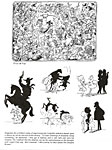 |
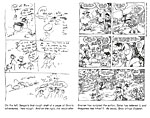 |
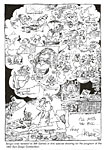 |
The foregoing first appeared in print in Cartoonist PROfiles Nos. 97 and 98, March and June 1993. I don’t know if the procedures for producing Groo are the same these days as they were a decade ago; probably they are. But it doesn’t matter: now you know how the cheese-dip loving barbarian was first concocted.
